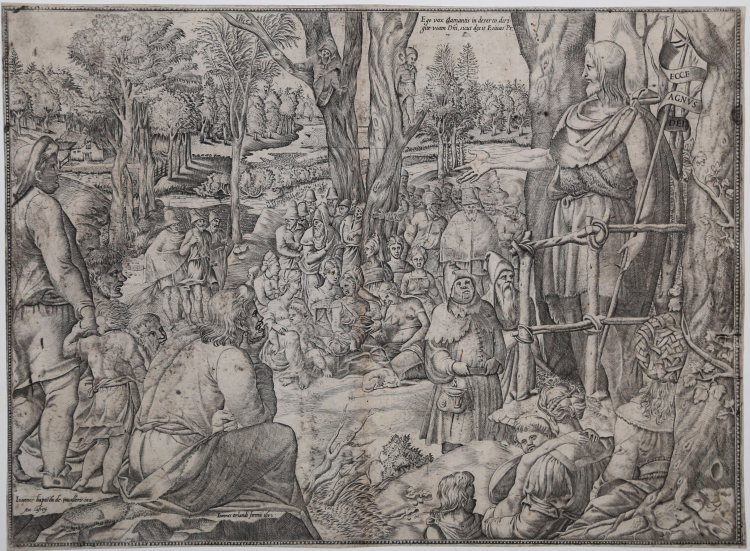




| Reference: | S30116 |
| Author | Giovanni Battista de’ CAVALIERI |
| Year: | 1602 |
| Measures: | 315 x 425 mm |



| Reference: | S30116 |
| Author | Giovanni Battista de’ CAVALIERI |
| Year: | 1602 |
| Measures: | 315 x 425 mm |
Engraving, signed at lower left. After Luca Penni. Example of the third state, with the address of the publisher Giovanni Orlandi and the date 1602- A good impression, printed on contemporary laid paper, trimmed to the platemark, trace of central folds, otherwise very good conditions.
The composition is derived directly from an engraving by Pierre Mignon, performed in Paris in 1550 , which is probably derived from a painting by Luca Penni. Compared to the model, the engraving by Cavalieri is in mirror image and without the rich ornamental frame. Le Blanc mistakenly identifies the model to a design by Andrea del Sarto.
The scene is set in a wooded landscape of the Flemish style, as suggested by the costumes of shepherds and of male figures gathered to listen, as well as the thatched roofs of the houses in the background on the left. In contrast, the figure of St. John the Baptist and the female figures with their classic hairstyle , clearly derive from the Renaissance style. The Baptist is depicted from a pulpit made from tree branches , and turns to the crowd and accompanied his sermon with a wave of his right hand. The crowd gathered is heterogeneous , consisting of men, women , boys and shepherds depicted on the trees. The work is a wonderful example of symbiosis between Nordic and Italian design elements , and evokes the rural setting , the spirit of Breughel.
A very rare work.
|
Le Blanc, 23; Scorsetti 14 II/III; Marigliani – Biguzzi, La Collezione Sacra della Bottega di Antonio Lafrery,p. 82, 51; Bassenge, Auktion 80, p. 26 n. 5208.
|
Giovanni Battista de’ CAVALIERI (1525-1601)
|
Engraver,printer and print publisher,from Villa Lagarina near Trento.Active in Venice and from 1559 in Rome.1577 he had a bottega in Parione which he let out to a cartolaio,Girolamo Agnelli. His own house was in the vicolo di Palazzo Savelli, with a workshop next to it. He was the brother-in-law of Lorenzo Vaccari.
Made plates for Antonio Salamanca, Lafrery and Faleti.By 1560 he seems to have been publishing his own plates. He entered into partnerships for publishing: in 1567 with Perino Zecchini de Guarlottis and in 1576 with Lorenzo Vaccari .In 1577 he was employng a printer: Francesco Cornuti .He acquired old plates that he recut. He published plates by his contemporaries,including Cort.He himself engraved after works of many artists,including Cort.He himself engraved after works of many artists,including Francesco Salviati,Daniele da Volterra, Raphael, Michelangelo, Polidoro da Caravaggio, Livio Agresti and Baccio Bandinelli.He also made copies of earlier prints.His subject matter included the devotional topographical,antiquarian,didactic and ‘popular’.
He published a number of important series: the Pontificum Romanorum Effigies of 1580 and the Romanorum Imperatorum Effigies of 1583; the Ecclesiae Anglicanae Trophea of 1584; the Antiquarum Statuarum Urbis Romae, the first book of which was first published before 1561/2.
|
|
Le Blanc, 23; Scorsetti 14 II/III; Marigliani – Biguzzi, La Collezione Sacra della Bottega di Antonio Lafrery,p. 82, 51; Bassenge, Auktion 80, p. 26 n. 5208.
|
Giovanni Battista de’ CAVALIERI (1525-1601)
|
Engraver,printer and print publisher,from Villa Lagarina near Trento.Active in Venice and from 1559 in Rome.1577 he had a bottega in Parione which he let out to a cartolaio,Girolamo Agnelli. His own house was in the vicolo di Palazzo Savelli, with a workshop next to it. He was the brother-in-law of Lorenzo Vaccari.
Made plates for Antonio Salamanca, Lafrery and Faleti.By 1560 he seems to have been publishing his own plates. He entered into partnerships for publishing: in 1567 with Perino Zecchini de Guarlottis and in 1576 with Lorenzo Vaccari .In 1577 he was employng a printer: Francesco Cornuti .He acquired old plates that he recut. He published plates by his contemporaries,including Cort.He himself engraved after works of many artists,including Cort.He himself engraved after works of many artists,including Francesco Salviati,Daniele da Volterra, Raphael, Michelangelo, Polidoro da Caravaggio, Livio Agresti and Baccio Bandinelli.He also made copies of earlier prints.His subject matter included the devotional topographical,antiquarian,didactic and ‘popular’.
He published a number of important series: the Pontificum Romanorum Effigies of 1580 and the Romanorum Imperatorum Effigies of 1583; the Ecclesiae Anglicanae Trophea of 1584; the Antiquarum Statuarum Urbis Romae, the first book of which was first published before 1561/2.
|